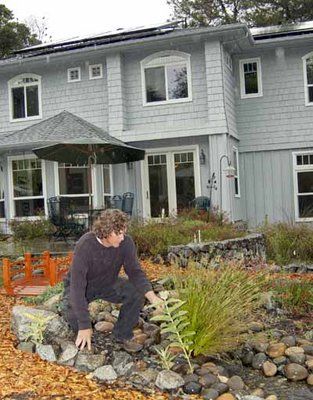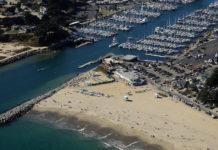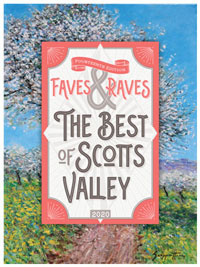
The terms “green building” and “green living” have only recently permeated the mainstream of cultural consciousness, but for one Felton family, they have been a way of life for more than 30 years.
Creating a greater awareness of the environment, and then putting that awareness into practice, has been the mission of Stu and Julie Phillips since they were college students in the 1970s.
Their shared love of nature grew out of early years surrounded by the natural splendor of the San Lorenzo Valley.
“For us, living in the valley and the beauty of the valley really influenced us,” Julie Phillips said.
In 2002, the two combined their professional fields of expertise — Stu Phillips as a green building contractor and Julie Phillips as a professor of environmental science at De Anza College — to create the Phillips Sustainable Living Center.
The modern, three-bedroom house uses environmentally friendly methods of generating power, heat and cooling to demonstrate how a home can be built to coexist with a natural habitat while leaving a minimal footprint on its surroundings.
“It became a way of life for us,” Julie said. “For us, this was a part of our family.”
Around the house is seven acres of native flora, such as ferns, manzanita and oaks. Native animals — including pests, such as gophers — are allowed to roam freely, while domestic animals, such as dogs and cats, are escorted off the premises.
“I love the nature part,” Julie Phillips said. “And Stu loves the building part.”
‘We had to make green building mainstream’
The Phillipses’house represents the culmination of Stu Phillips’ experience designing and building homes that use what is called a passive solar design. He built his first passive solar house in Boulder Creek in 1980.
“We had to get people to understand that passive solar was viable,” Julie Phillips said. “We had to make green building mainstream.”
Every decision they made about their house kept the environment in mind — from the selection of natural wool carpeting to the direction the house faces.
The house faces due south, with the large windows and eaves along that side of the house designed to let in the maximum sunlight during the winter, when the sun is lower in the sky, and as little as possible during the warm summer months.
The amount of sunlight that touches the dark tile floors determines the temperature of the concrete beneath, called the thermal mass. During winter, it soaks up the sun’s warmth during the day and radiates that heat at night; in summer, it is sheltered and keeps the house cool.
“The highest (temperature) it’s ever gotten in here is 75 degrees,” Stu Phillips said. “It fluctuates by only 5 degrees.”
He explained that designing a house to regulate heat by sun exposure is not a new concept, but a tradition that he and his wife are encouraging people to relearn.
“All the historic buildings faced the equator,” he said.
Julie Phillips explained that the increased use of fossil fuels and electricity to heat and power homes led to a disregard for historical passive solar lessons.
“When oil got cheap, people got lazy,” she said.
Stu Phillips noted that building a passive solar home costs little or no more than any other home, but the technique can dramatically reduce a household’s energy use when combined with solar panels to power lights and other electronics.
“Our utility bill for last year was negative-$7,” Julie Phillips said.
Stu Phillips acknowledged that in densely forested areas of the San Lorenzo Valley, passive solar design is more difficult to achieve, particularly in existing homes — but not impossible.
Homes in shaded areas can use a combination of dense insulation and an auxiliary system of heating and cooling the thermal mass via water pipes running under the concrete, he said.
“That’s the beauty of it; there’s no extra cost,” he said, adding that certified sustainable lumber materials are readily available at places such as Home Depot and cost nothing extra. “It’s just how you build the house.”
‘Our job is to help everyone learn what we learned’
To promote their brand of sustainable living, the Phillipses have opened the Sustainable Living Center to those wanting to learn to live closer to nature and tread a little more lightly on the planet.
“We try to teach people to reconnect with nature,” Julie Phillips said. “We’ve been doing tours for five years.”
The couple regularly hosts workshops, open houses and garden tours to educate entire families about the benefits of living as they do.
“Our job is to help everyone learn what we learned,” she said, stressing the need for organic, healthy foods and regular exposure to natural light. “These things bring a lot of happiness.”
Families looking to get in tune with a sustainable way of life can rent the passive solar house for a vacation to learn about the environment. The Phillipses also offer composting tips and suggestions to minimize environmental impact.
“The beauty of living in this valley is a gift,” Julie Phillips said. “To us, that comes with a responsibility.”
Sustainable living workshop
Where: Phillips Sustainable Living Center, 310 El Alamein Road, in Felton
When: 5:30 to 7:30 p.m. June 15, a Friday
Cost: Free; reservations required
Info: www.phillipssustainableliving.com











